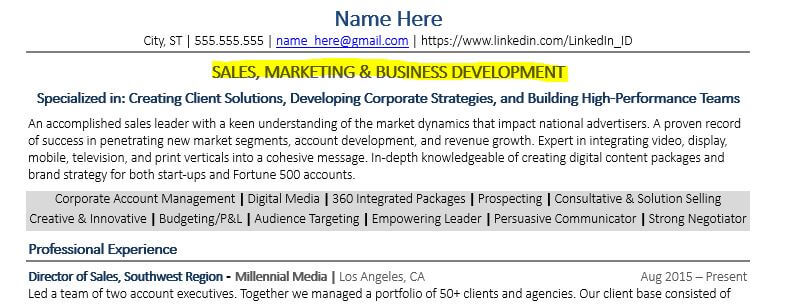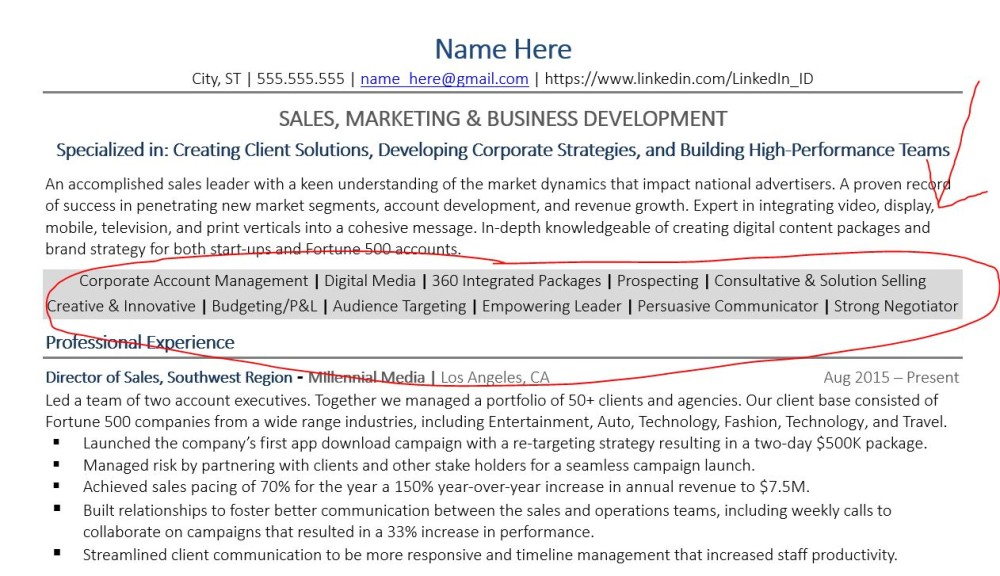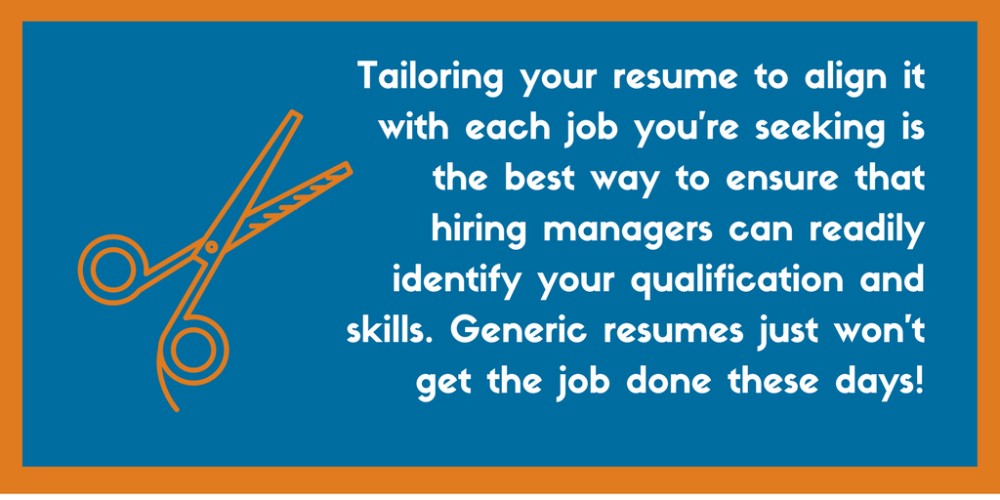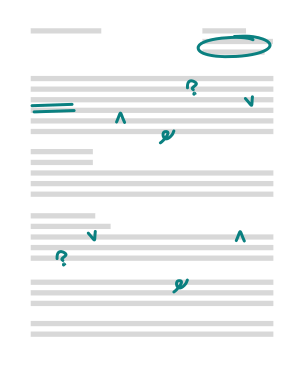How to Tailor Your Resume to Different Positions (Examples)

9 min read

As a job seeker, it’s frustrating to discover that your resume just isn’t connecting with hiring managers and recruiters. One problem is that far too many job seekers create one resume and use it for every application they submit. That approach is never going to give you the best chance of landing an interview for the quality new job that you need.
To maximize your odds of getting hired for the job you’re applying for, you need to learn how to customize your resume to different positions. Professional resume writers call this process "tailoring" your resume.
Why you need to know how to tailor your resume
Think about things from a hiring manager’s perspective for a moment. If you’re trying to fill a project management or customer service manager position, what do you want to see? Do you want to review a generic resume that could apply to any job? Or would you prefer one that seems as though it was written with your company in mind? The answer should be obvious.
The truth is that you need to tailor your resume during the job search to have any real chance or positive results against other applicants. That’s the only way to ensure that you are properly addressing a given company’s job requirements. This is also the best way to demonstrate to a hiring manager or employer that you’re the right candidate for the open position. Non-specific resume templates simply can’t achieve that objective.
Do you need multiple versions of your resume?
No--it’s easy tailoring your resume if it’s formatted properly. The trick is to make high-impact keyword changes while maintaining the basic structure of your resume. When done correctly, it should only take a few minutes. This post will walk you through how to tailor your resume like a professional resume writer!
Tailor your resume with keywords
The secret to tailoring your resume to every job description quickly is to leverage keywords throughout your resume. You want to make your resume the perfect fit for a certain position. That means trimming, expanding, and adapting your resume to fit the job requirements--as a tailor does with a piece of clothing.
Why is tailoring a resume so important?
There are many answers but it boils down to this: when your resume is a good fit for the job, you’re more likely to earn an interview. From there, a stellar interview will help you land the job. Your resume is the first step.
An effective resume will appeal to employers and the tools they use to organize and sort resumes: Applicant Tracking Systems, or the ATS. Both of these audiences scan over your resume for keywords that describe your skills, experience, education, and other qualifications. This article will tell you where to find those keywords and where to insert them on your resume.
What are resume keywords?
Keywords are specific to each job description. If a job description lists experience with customer service as a requirement, your resume should include the exact phrase “customer service.” Ideally, it should include the words “customer service” more than once.
The job description is describing the ideal candidate. To tailor your experience and fit that description, you should use the exact phrases provided. Don’t try to stand out by describing your “client liaison” skills; the ATS and the employer want to see your “customer service” experience. That is the resume keyword.
Expert Tip
Read our complete guide on exactly how to use keywords on your resume.
How do I use keywords?
By placing the right job keywords in the right places on your resume, you can satisfy those applicant tracking scanners and human readers. Your resume will be a great fit for each job.
This means you should be selective about what jobs you apply to. You should keep your resume accurate, so only include keywords (skills, experience, and education) that you actually have. ZipJob’s team of career experts suggest active job seekers apply to 10 to 15 jobs per week with a highly-tailored resume.
In theory, all you need to do to successfully tailor your resume is to identify relevant words from a job description and use those keywords in your resume. In practice, you need both a solid, flexible resume and an eye for picking out the important parts of a job description.
The easiest places to tailor your resume quickly are your resume title or headline, your core competencies, your professional summary, and finally your work experience section.
1. How to tailor your resume using the title
A resume title (also known as a resume headline) is a big opportunity most job seekers miss out on. Your resume title, as opposed to your job titles, can reflect your career goals and key qualifications. It’s not an official title: it’s a headline that previews your resume in a few words.
To see the most impact here, the title of each tailored resume that you send out needs to be specific and directed toward that particular open position.

Don’t just use a job title that says, “Marketing Manager” if the open position calls for a Director of Marketing. Use that designation instead, and back it up with some professional qualifications. For example, write “Director of Marketing – Master’s Degree and Seven Years Marketing Management Experience.”
For more examples, check out our advice on crafting the perfect resume title here.
2. How to tailor your resume using your core competencies
The second best place to tailor your resume is the core competencies section. At ZipJob, we favor core competency sections over skills sections because a job seeker’s competencies often include both skills and personality traits or behaviors.
Like a resume title, your core competencies can be tweaked to better suit a given position. In fact, core competencies can be one of the most important resume areas that will get your resume noticed!
Your resume should align with the keywords used in the specific job description. The core competencies, as a targeted list of skills and abilities, is a great place to swap out general words for keywords.
For example, if a position requires web design/development experience, you want to ensure that those keywords are on the resume. You can start by placing that keyword phrase in your core competencies section. Highlight your practical experience by using the phrase again in your work experience section. We’ll talk more about that later on.
Here is an example of a core competencies section where you can easily tailor your keywords to the job description:

Your core competencies include your relevant knowledge base and skills. When you develop your tailored resume, you should make sure that these competencies are detailed using the job description keywords. That can help you in two important ways:
Use the job description’s keywords to help you focus your resume on that company’s open position
Use keywords to help your resume get past automated Applicant Tracking Systems and into the hands of a live human
You should use short phrases to describe the skills. List those core competencies in your summary to ensure that recruiters and hiring managers see them. That helps to dispel any doubts about whether you’re a qualified fit for the specific job by directly answering that question as early in the resume as possible.
Expert Tip
Our resume experts tend to prefer a Core Competencies section over a skills section. Learn how to write your own with this guide: Core Competencies Section on a Resume
3. How to tailor your resume using the summary
Your resume summary is another powerful tool that can help you customize your resume to a job posting. Like the resume title and the core competencies section, the summary is often either overlooked or inefficient.
To make maximum use of it, you should begin by identifying the employer’s desired qualifications. This is the key difference between a resume objective and a resume summary: the resume summary must be employer-focused.
You can then work to align your relevant experience and qualifications with what the employer requires. You must remove anything that isn’t relevant to the position.
Instead, add the qualifications, experiences, and other information that supports your candidacy. Keep the most relevant information toward the beginning of your resume’s professional summary. You can end with impressive information that is not required, such as foreign language fluency, awards won, or bonus technical skills.

4. How to tailor your resume using your employment history
This tailoring trick is the most time consuming task on our list, but it is effective. If there are only a handful of similar positions you’re applying to, then you should be tweaking your work experience section.
As tempting as it might be to just leave your employment history intact for each submission, that can cause you to miss opportunities. You should edit job descriptions and achievements to improve how closely they align with the job you’re seeking. Customize those entries so that they shine a spotlight on skills and work experience that demonstrate that you’re the right person to handle the new position.
To do this efficiently, refer back to the job description. The keywords you added to other parts of your resume (at this point, that should be the resume title, core competencies, and professional summary sections) can be expanded upon here.
Let’s say you added Photoshop as a core competency. In fact, you’re so good at Photoshop because you created all the social media graphics and marketing materials for your last job. Including a bullet point with these details in the work experience section will help an employer understand your level of ability with this skill. In comparison to the candidate who only listed Photoshop in a generic skills section, you come out far ahead!

Summary
While it definitely takes some extra effort to tailor your resume for different types of positions, it is an absolute necessity if you want to get noticed these days. Generic, one-size-fits-all resumes just won’t cut it anymore. A well-tailored resume will maximize your odds of job search success. So, learn to tailor your resume to a job posting the right way; chances are that it’s just what you need to finally get that job you deserve.
If you need help, reach out to the career experts at Zipjob. We are a resume writing service with over 100 professional resume writers ready to help you impress recruiters and hiring managers.
Get started with a free resume review from one of our experts to see if your resume needs an update.

Related reads:

Written by
Leo Bastone, Editor & Content Writer
Leo Bastone is an Editor with a passion for using words to empower high-growth and mission-driven organizations. He’s worked in startup, non-profit, and enterprise environments across various sectors and currently serves as an editor at ZipJob. Based out of the greater New York City area, Leo enjoys traveling frequently throughout New England, one of his favorite hideaways being the Pioneer Valley of western Massachusetts.
